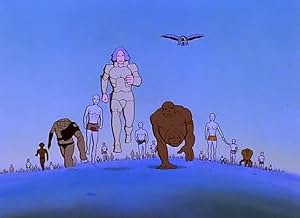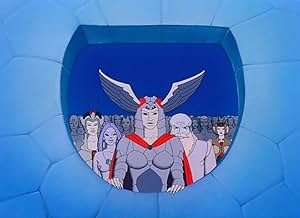Gandahar
- 1987
- Tous publics
- 1h 18min
NOTE IMDb
7,0/10
5,7 k
MA NOTE
Pour avoir oublié le monstre Métamorphe au fond d'un océan, les Gandahariens, habitants d'une heureuse planète, sont voués à la disparition. Métamorphe devra les ressusciter afin de puiser e... Tout lirePour avoir oublié le monstre Métamorphe au fond d'un océan, les Gandahariens, habitants d'une heureuse planète, sont voués à la disparition. Métamorphe devra les ressusciter afin de puiser en eux l'énergie nécessaire à son immortalité.Pour avoir oublié le monstre Métamorphe au fond d'un océan, les Gandahariens, habitants d'une heureuse planète, sont voués à la disparition. Métamorphe devra les ressusciter afin de puiser en eux l'énergie nécessaire à son immortalité.
- Récompenses
- 1 nomination au total
Glenn Close
- Ambisextra
- (English version)
- (voix)
Christopher Plummer
- Metamorphis
- (English version)
- (voix)
Georges Wilson
- Métamorphe
- (voix)
Anny Duperey
- Ambisextra
- (voix)
Dominique Maurin
- Transformés
- (voix)
- (as Dominique Maurin-Collignon)
Jean Saudray
- Transformés
- (voix)
Philippe Noël
- Transformés
- (voix)
Histoire
Le saviez-vous
- AnecdotesThe film is based on the 1969 novel "Les Hommes-machines contre Gandahar" (The Machine-Men versus Gandahar) by Jean-Pierre Andrevon.
- Versions alternativesThe Miramax Dubbed version is edited from the original French release. Most of the editing is from the first 36 minutes from the film. In the Miramax cut there is a new introduction of a quote by Issac Asimov, and an extended ending using footage from earlier in the film. The French cut ends with the head floating through the air. The French version contains roughly 6 minutes and 37 seconds more footage than the Miramax version(not including the Opening Titles and Credits). A lot of this is dialogue and more intimate scenes between Sylvain and Airelle in the nest and on the ship to Métamorphe. There is also a sequence cut of the black robots which is also shown in a montage inside Métamorphe later in the film.
- ConnexionsEdited into The History of the Hands (2016)
Commentaire à la une
It's not an outstanding movie by any means, but it gets the job done and entertains. One has to remember that when viewing sci-fi often the plot takes precedence over character. Most plot driven films and stories are like that: We're given the bare bones of our protagonist, and watch him or her weave their way through a story.
Such it is with "Light Years." The animation is certainly above the quality of your typical commercial studio, but is not as dazzling as say a Japanese Anime space opera, nor a Disney Production feature; but it does have a certain quality unto itself. Even so the movie could've used more shots (cutaways and general coverage) to help move the story and highlight the characters more. As it stands more the shots are rather static, and the animation in them shifts gears a little too often. In some scene the animation is very smooth, where other times is seems very long and drawn out, or just not well staged.
The film itself has action, but some of the it is stilted and painfully slow, where other times it moves quite well. The dubbing is adequate, though, like all dubbed films, one gets the sense that it doesn't quite catch the tones and inflections of the voices from the original French cast.
Technology and regimented existence are pitted against the organic and under-dogs of Ghandahar in a typical sci-fi theme. The film's worth a night's rental, and if you like collecting rare sci-fi this might be one to add to your collection. Otherwise it may only be worth a single viewing.
*EDIT* French Region 2 DVD review, Jan 3, 2010
Well, I finally saw the original French film in all its entirety. As an American I have to say that I appreciate the additional footage, and can nod at the more subtle pacing, but I do have to say that I think the Americanized version has some pluses going for, namely in the music. The original French score underlines the basic theme of what is being presented. There are no heroics on the battlefield nor purely desperate moments as would be conveyed by the American musical score. The other subtleties are apparent, and I think I better understand why the American producers did what they did by sexing up what they could. The French film is more prosaic and "European" (for lack of a better term) in its presentation of a world in crisis. There's an emotional malaise characteristic of European cinema as a whole that comes across in the original French version. There's a subtle (and not so subtle) nihilistic quality here. Perhaps there's a bit of Nazi occupation still resonating within this film.
All I can really say is that it's a different film from the American version. I'm not sure I prefer one too much over the other. There's a lack of celebration in the French film. There's a kind of fatalistic quality to that is twisted but still present in the American version. Whereas the French version of this film emphasizes weathering the storm and completing the objective, the American version emphasizes confronting the challenge in a way that we Americans have always done. There's a lack of ambient depression that seems to hang and mildly envelope European art, film included. A kind of ethereal drawn out emotionalism that you'd never see in an American film, but is fairly strong in Russian and Swedish cinema, and hits French and Italian films in a less powerful vein.
I would be interested in seeing a DVD of the American version to make a more thought out and proper comparison. But I guess that'll have to wait.
Such it is with "Light Years." The animation is certainly above the quality of your typical commercial studio, but is not as dazzling as say a Japanese Anime space opera, nor a Disney Production feature; but it does have a certain quality unto itself. Even so the movie could've used more shots (cutaways and general coverage) to help move the story and highlight the characters more. As it stands more the shots are rather static, and the animation in them shifts gears a little too often. In some scene the animation is very smooth, where other times is seems very long and drawn out, or just not well staged.
The film itself has action, but some of the it is stilted and painfully slow, where other times it moves quite well. The dubbing is adequate, though, like all dubbed films, one gets the sense that it doesn't quite catch the tones and inflections of the voices from the original French cast.
Technology and regimented existence are pitted against the organic and under-dogs of Ghandahar in a typical sci-fi theme. The film's worth a night's rental, and if you like collecting rare sci-fi this might be one to add to your collection. Otherwise it may only be worth a single viewing.
*EDIT* French Region 2 DVD review, Jan 3, 2010
Well, I finally saw the original French film in all its entirety. As an American I have to say that I appreciate the additional footage, and can nod at the more subtle pacing, but I do have to say that I think the Americanized version has some pluses going for, namely in the music. The original French score underlines the basic theme of what is being presented. There are no heroics on the battlefield nor purely desperate moments as would be conveyed by the American musical score. The other subtleties are apparent, and I think I better understand why the American producers did what they did by sexing up what they could. The French film is more prosaic and "European" (for lack of a better term) in its presentation of a world in crisis. There's an emotional malaise characteristic of European cinema as a whole that comes across in the original French version. There's a subtle (and not so subtle) nihilistic quality here. Perhaps there's a bit of Nazi occupation still resonating within this film.
All I can really say is that it's a different film from the American version. I'm not sure I prefer one too much over the other. There's a lack of celebration in the French film. There's a kind of fatalistic quality to that is twisted but still present in the American version. Whereas the French version of this film emphasizes weathering the storm and completing the objective, the American version emphasizes confronting the challenge in a way that we Americans have always done. There's a lack of ambient depression that seems to hang and mildly envelope European art, film included. A kind of ethereal drawn out emotionalism that you'd never see in an American film, but is fairly strong in Russian and Swedish cinema, and hits French and Italian films in a less powerful vein.
I would be interested in seeing a DVD of the American version to make a more thought out and proper comparison. But I guess that'll have to wait.
Meilleurs choix
Connectez-vous pour évaluer et suivre la liste de favoris afin de recevoir des recommandations personnalisées
- How long is Gandahar?Alimenté par Alexa
Détails
Box-office
- Montant brut aux États-Unis et au Canada
- 370 698 $US
- Week-end de sortie aux États-Unis et au Canada
- 48 665 $US
- 31 janv. 1988
- Montant brut mondial
- 370 698 $US
- Durée1 heure 18 minutes
- Couleur
- Mixage
- Rapport de forme
- 1.33 : 1
Contribuer à cette page
Suggérer une modification ou ajouter du contenu manquant




























